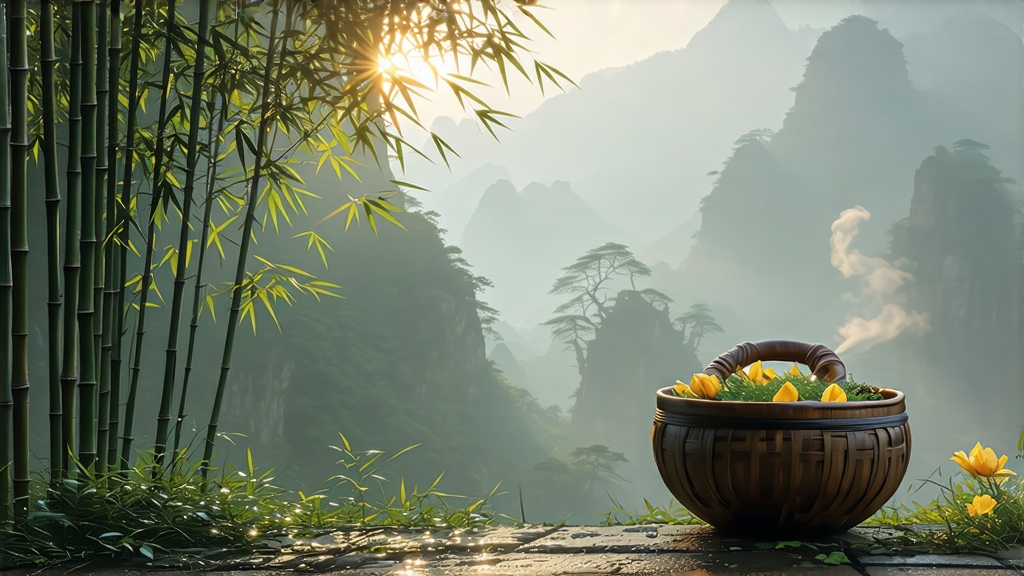
Hidden high above the Sichuan basin, where perpetual cloud veils the Min River valley, lies the legendary Meng Ding Mountain. For twelve centuries its name has been whispered among tea connoisseurs as the birthplace of the earliest known yellow tea—Meng Ding Huang Ya, “the yellow bud of Meng Ding.” Unlike the better-known green teas that surround it, this rare yellow tea carries the echo of Tang-dynasty court ceremony in every down-covered tip. Today only a few hundred kilograms reach the market each spring, making a encounter with Meng Ding Huang Ya less a purchase than a pilgrimage.
History: from altar to emperor
Buddhist monks planted the first tea gardens here during the Han dynasty, believing the mountain’s mist to be “heavenly breath” that could sanctify drinking water. By the Tang era (618-907) the tea was pressed into cakes and carried along the Jiannan caravan road to Chang-an, where palace annals of 808 CE record it as one of three teas used in the Altar of Heaven rites. When Song emperor Huizong—himself a skilled tea artist—visited Sichuan in 1112, local gazettes claim he renamed the bud “huang ya” after noticing the leaves turned translucent golden after three days of slow yellowing. The Ming finally shifted the tea from compressed cakes to loose leaf, but kept the imperial levy; any farmer who sold huang ya outside the tribute system risked flogging. After the 1911 revolution the gardens were abandoned to weeds, and the technique survived only because three families in Shangqing village continued to fire tiny batches for home consumption. Rediscovered in 1956 by a Sichuan agricultural survey team, Meng Ding Huang Ya was revived as a state gift to foreign dignitaries, yet it remains one of the least studied of China’s six tea classes.
Micro-terroir: why the mountain matters
Meng Ding rises 1 456 m above sea level, trapping humid air from the Min River and creating 280 fog-bound days a year. The short-wave ultraviolet light filtered through cloud cover slows photosynthesis, increasing amino acids (especially L-theanine) while keeping catechins low. The soil is a crumbly quartz-rich yellow loam, pH 4.7, laced with bamboo root networks that release silica—an element tea chemists link to the cultivar’s signature orchid note. Only three clones—Meng Ding #9, #16 and the ancient seed-grown “xiao ye zhong”—are permitted for authentic huang ya. The picking window opens when 5 % of the garden’s buds reach “sparrow’s tongue” length (22–25 mm) and still wear their winter down; this occurs between March 20 and April 5, give or take a lunar leap year.
Craft: the secret of men huan—sealed yellowing
Yellow tea’s defining step is “sealed yellowing,” a slow oxidation that occurs after kill-green but before full drying. Meng Ding masters call this men huan, literally “the suffocating return.” Immediately after pan-firing at 160 °C for four minutes, the leaves are piled in bamboo trays lined with wet cotton and slid into a pine-wood cabinet. For the next 48 hours the tea maker refuses sleep, turning the pile every 90 minutes to maintain 35 °C and 78 % humidity. Enzymatic oxidation—neither green nor black—transforms chlorophyll into pheophytin, catechins into theaflavins, and releases a honey-like aroma that perfumers liken to mimosa. When the leaf edges turn primrose and the stem snaps with a faint “cui” sound, the tea is briefly re-fired at 80 °C, then rested for another 24 hours to stabilize. The entire process consumes 4.2 kg of fresh bud to yield 1 kg of finished tea, one reason for its rarity.
Grades & leaf style
Meng Ding Huang Ya is sorted into four grades, not by size but by the integrity of the down and the success of the yellowing.
- Imperial Sparrow Tongue: single buds, 100 % down intact, golden jade color, orchid-honey fragrance.
- First Grade: one bud and one unfolded leaf, down 80 % intact, liquor brighter than a topaz.
- Second Grade: one bud and two leaves, down 50 %, still shows “golden ring” on the rim of the cup.